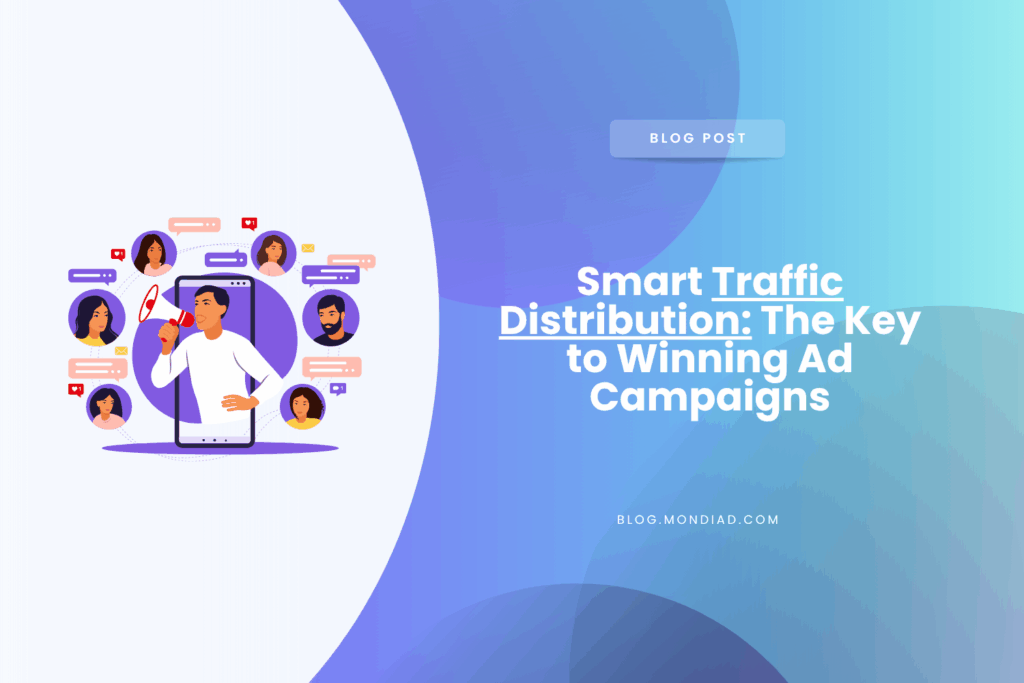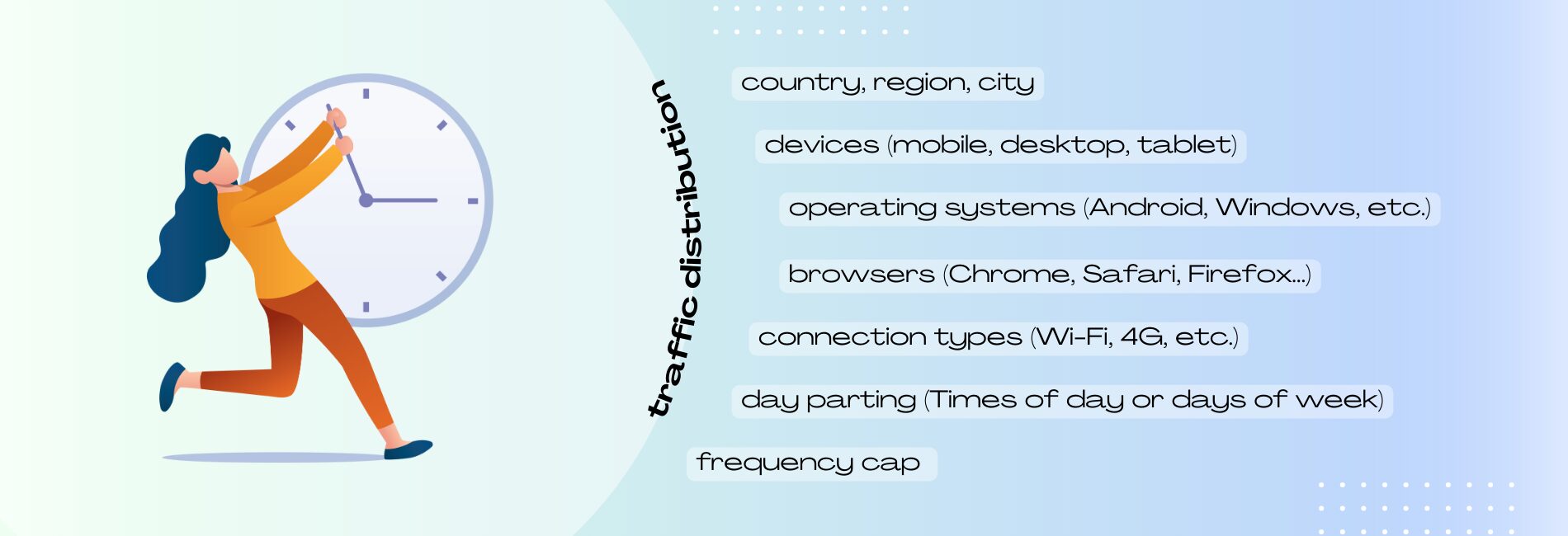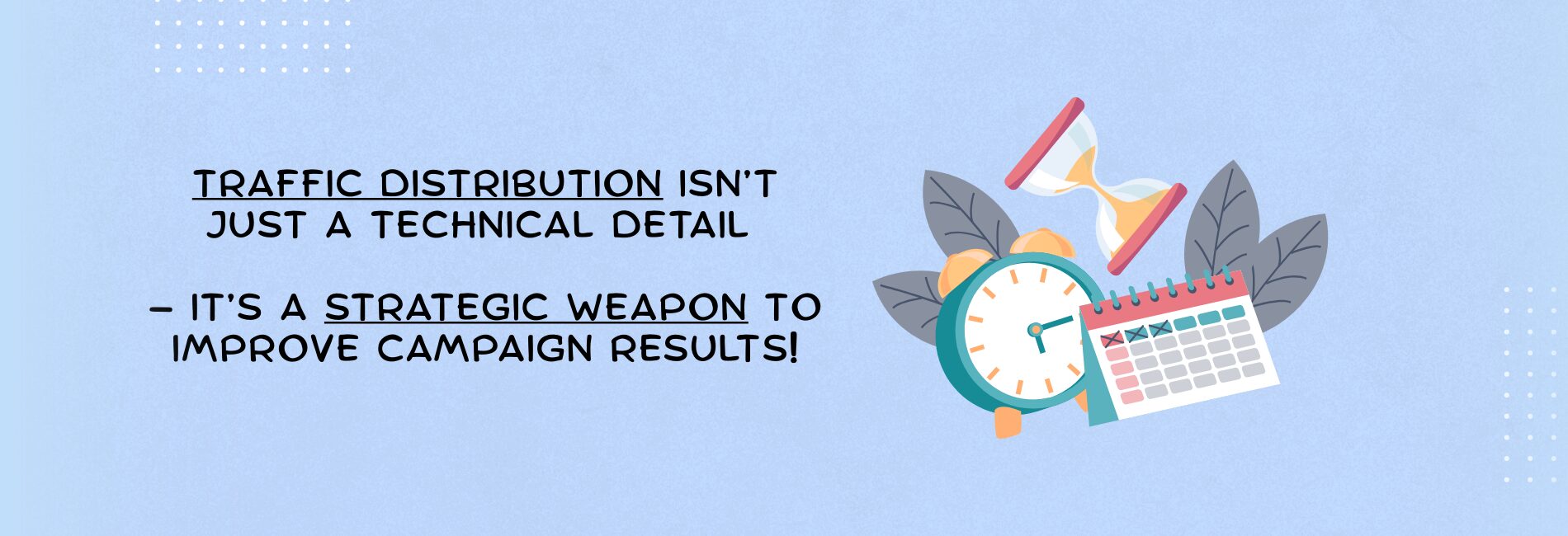Whether you’re an advertiser aiming to boost conversions or a publisher looking to optimize monetization, understanding how traffic flows, and when it peaks, is essential.
As we work with thousands of campaigns across the globe, and we’ve seen one clear truth: your results are only as good as your traffic targeting. So, let’s break down what traffic distribution really means, why it matters for your results, and how to take control of it on our platform.
What Is Traffic Distribution?
In a nutshell, traffic distribution is how your traffic is spread across different parameters, like:
- GEOs (country, region)
- Devices (mobile, desktop, tablet)
- Operating Systems (iOS, Android, Windows, etc.)
- Browsers (Chrome, Safari, Firefox…)
- Connection types (Wi-Fi, 4G, etc.)
- Carrier vs Wi-Fi users
- Times of day or days of week
Even if you select a broad targeting setting, traffic never distributes evenly. Some segments might get more volume, some get better engagement, and others just eat up budget with no returns.
As a media buyer, understanding and managing this distribution is key to getting the best performance at the lowest cost. It’s a crucial factor that impacts campaign performance, ad visibility, and ultimately, ROI.
- Are your ads reaching the right audience at the right time?
- Are you allocating your budget evenly across all geos, or prioritizing top-performers?
- Are you bidding competitively for high-converting segments (e.g., Android users in Tier 1 countries)?
Why Traffic Distribution Matters
If you’ve ever launched a campaign that got a ton of traffic but barely converted, you’ve already experienced what poor traffic distribution feels like.
Some common issues:
- Over-delivery in low-performing GEOs
- Too much budget spent on high-volume but low-intent users
- Strong converting segments underfunded due to default settings
- High CPCs on low-profit traffic
So, traffic distribution matters for advertisers because it directly impacts the quality, efficiency, and results of their campaigns.
Here is how it helps:
Better Targeting and Segmentation
Test which segments convert best, thus reach specific audiences based on behavior or location
Budget Optimisation
Distribution ensures that budget is allocated smartly based on data.
Smarter Optimization
When traffic is well-distributed, it gives advertisers more data to analyze. This helps with spotting trends across devices, geos, or ad formats.
Reduces Ad Fatigue
Spreading traffic minimizes the risk of user fatigue from seeing the same ad.
Traffic Distribution Best Practices
We provide granular control over your campaigns so you can shape your traffic strategy based on data. Here’s how to make it work for you:
1️⃣ Start broad, then narrow
Test a wide range of settings, analyze the data, and then refine your targeting and schedule.
2️⃣ Think in Micro-Segments
Don’t treat all GEOs or devices equally. Break your campaign into segments (e.g., separate mobile/desktop, or Tier 1/2/3 GEOs) to analyze performance more accurately. Instead of “mobile in Mexico,” think “Android + Wi-Fi + Chrome in Mexico.”
3️⃣ Align with user intent
Think about when your audience is in “conversion mode.” A utility app might perform better during work breaks, while dating or entertainment offers could spike late at night.
4️⃣ Monitor Real-Time Reports & Adjust Accordingly
Regularly monitor your campaign reports to spot any imbalances. Adjust your targeting and bids to focus more on high-performing segments. Let the data guide your decisions.
Look beyond the total numbers, analyze each segments (device, OS, browser, etc.) and spot trends: Is Android converting better? Are conversions dropping at a certain hour? Are there strong morning conversions in Europe or evening peaks in LATAM?
5️⃣ Use Automation Rules
Automate campaign optimisations: pause low-performing segments, increase bids on top performers, or scale budgets during high-conversion times. It’s all designed to put you in control, whether you’re scaling a campaign or testing a new vertical.
6️⃣ Test Often
What works today may shift tomorrow based on user behavior or competition.
7️⃣ Talk to Your Account Manager:
They’ve seen what’s working and can suggest strong segments or hidden opportunities.
8️⃣ Combine time-based data with your traffic segmentation. A high-performing GEO might only work well during specific hours.
Understanding peak traffic times is crucial to getting the most out of your ad spend. These are the hours when your target audience is most active, engaged, and likely to convert. And yes, it varies by GEO, device, vertical, and user intent.
As a media buyer, monitoring traffic trends by hour and day of the week helps you:
- Spend budget during high-converting hours
- Avoid wasting impressions in dead zones
- Scale campaigns more efficiently during hot windows
9️ Apply Frequency Caps and Limits
Avoid oversaturating segments by limiting impressions per user. This protects performance and ensures better distribution across your target pool.
Frequency Cap is the number of times and the timeframe (in hours, starting with 1 hour) your ad will be shown to a visitor.
Example: If you set the cap to 5 times in 24 hours, a visitor will see the ad a maximum of 5 times within a 24-hour period.
1️⃣0️⃣ Time zone matters
Always check if your ad schedule aligns with the target geo’s local time. If you’re running across multiple time zones, schedule your campaigns based on the local time of the GEO, not your dashboard time.
1️⃣1️⃣ Use day parting: Not all hours are equal. One smart hour of traffic can outperform an entire day of poorly timed exposure. Schedule your ads to appear only during high-converting windows, or adjust bids based on the time of day.
Day parting (aka ad scheduling) lets you control when your ads are shown, by hour or by day. This feature is especially powerful for optimizing ad spend and user engagement.
– If your offer performs best in the evenings or weekends, why waste budget in low-converting hours?
– Running a flash sale? Use day parting to go heavy during the promo window and pause afterward.
– Avoid ad fatigue by rotating campaigns strategically based on time zones and user behavior.
Real-World Example
Let’s say you’re running a sweepstakes offer targeting Latin America. You launch broadly across 5 countries, mobile only. After 24 hours, your report shows:
- Brazil: 60% of spend, 10% of conversions
- Mexico: 15% of spend, 40% of conversions
- Colombia, Argentina, Chile: low volume, decent CTR, mixed CR
What now?
→ Reduce bid or cap spend in Brazil
→ Increase bid or open budget in Mexico
→ Split campaigns by GEO and optimize each one individually
→ Test Wi-Fi vs Carrier to isolate user behavior
Small tweaks = big gains. 😉
Traffic distribution isn’t just a technical detail, it’s a strategic weapon. So, don’t just run campaigns, run optimized campaigns. Your audience is always online somewhere, make sure you’re showing up at the right time, in the right place, with the right message.
If you want help segmenting your campaigns, adjusting your bids, or building a strategy that scales, reach out. Our team’s here to support you every step of the way.
Let’s make your traffic work smarter.



